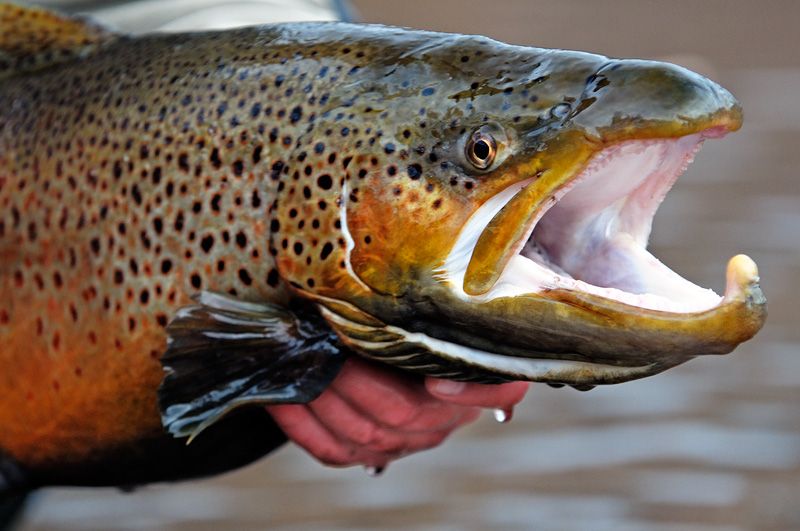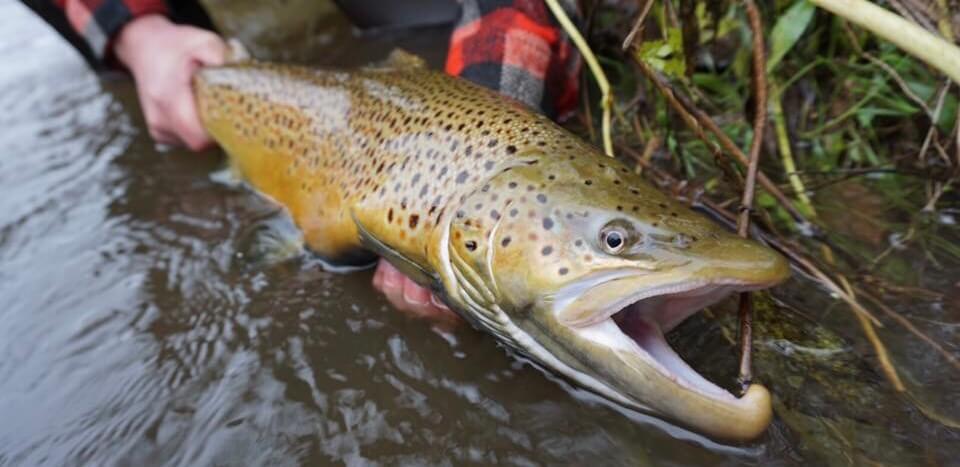Brown trout
Brown Trout

Illustration by Joseph R. Tomelleri ©
Salmo trutta – scientific name
IDENTIFICATION:
Brown trout can be hard to identify. Learn more about identifying Atlantic salmon, Chinook salmon, coho salmon, rainbow (steelhead) trout and brown trout.
Dorsal and adipose fin, broad square tongue with 11 to 12 large teeth, light pectoral fins, square tail, and nine to 10 rays in the anal fin.
Lake-run browns are predominately silver in color and the body spots are often obscured in lake-dwellers compared to the resident stream dwellers. The average lake run adult weighs eight pounds, although individuals can grow to be much larger.
FISHING:
Brown trout provide good fishing in many, mostly northern Michigan, inland lakes. Anglers use a wide variety of methods, from fishing with live bait on the bottom to trolling with minnows or artificial baits. In the Great Lakes, brown trout can offer outstanding sports in the early spring – often before other species begin to bite – to anglers who wade, fish from piers with live bait or artificial lures, or who troll in largely inshore water with imitation minnows or other plugs. Browns are often taken in conjunction with coho in the spring or incidentally with other salmon during the summer.
Brown trout in streams are usually more cooperative on rainy or overcast days. Though they will take all manner of live bait as well as spinners or artificial minnows, brown trout are a favorite of fly fishermen, many of whom pursue them after dark during notable insect hatches, especially the giant Michigan mayfly (Hexagenia limbata). But large streamers and big splashy surface flies, such as mouse patterns, produce well, too.
Some of Michigan’s best known trout streams – such as the Au Sable, the Pere Marquette and the Manistee Rivers – are noted for their brown trout fisheries. Inland brown trout lakes include Higgins, Burt, Mullet, McCormick (near Atlanta) and Bear (Kalkaska County).
DIET:
The diet of adult brown trout includes insects and their larvae, crustaceans, mollusks, amphibians, small rodents and other fish.
LIFE HISTORY:
In spring time you will find them in shallow, rocky, boulder-strewn areas, and they prefer a water temperature of 50-65 degrees F. Since brown trout spawn in tributary streams in September and October, they begin to take up residence near stream outlets in late summer to early fall. After ascending a particular stream, brown trout spawners choose shallow, gravelly or rocky areas. The female creates a shallow depression (redd) in the gravel, in which the spawning fish deposit the eggs and sperm. When the process is completed, the female covers the redd with gravel.
BACKGROUND INFORMATION:
Native to Europe and parts of Asia, brown trout were introduced to Michigan in 1883 – one of the first states to import them into North America – they now thrive statewide. Brown trout are more tolerant of warmer water temperatures than other trout species, and as a result, browns have become the principle target of anglers in many rivers across the state, ranging from Michigan’s best-known trophy waters to small, marginal trout streams in southern Michigan.



